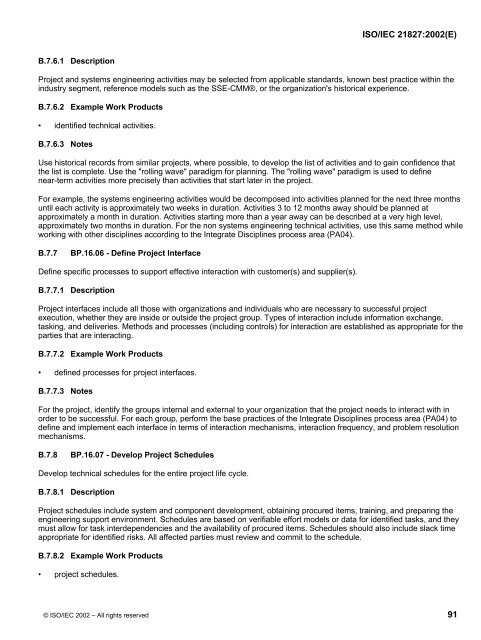ISO/IEC 21827
ISO/IEC 21827
ISO/IEC 21827
Create successful ePaper yourself
Turn your PDF publications into a flip-book with our unique Google optimized e-Paper software.
<strong>ISO</strong>/<strong>IEC</strong> <strong>21827</strong>:2002(E)<br />
B.7.6.1<br />
Description<br />
Project and systems engineering activities may be selected from applicable standards, known best practice within the<br />
industry segment, reference models such as the SSE-CMM®, or the organization's historical experience.<br />
B.7.6.2<br />
Example Work Products<br />
• identified technical activities.<br />
B.7.6.3<br />
Notes<br />
Use historical records from similar projects, where possible, to develop the list of activities and to gain confidence that<br />
the list is complete. Use the "rolling wave" paradigm for planning. The "rolling wave" paradigm is used to define<br />
near-term activities more precisely than activities that start later in the project.<br />
For example, the systems engineering activities would be decomposed into activities planned for the next three months<br />
until each activity is approximately two weeks in duration. Activities 3 to 12 months away should be planned at<br />
approximately a month in duration. Activities starting more than a year away can be described at a very high level,<br />
approximately two months in duration. For the non systems engineering technical activities, use this same method while<br />
working with other disciplines according to the Integrate Disciplines process area (PA04).<br />
B.7.7<br />
BP.16.06 - Define Project Interface<br />
Define specific processes to support effective interaction with customer(s) and supplier(s).<br />
B.7.7.1<br />
Description<br />
Project interfaces include all those with organizations and individuals who are necessary to successful project<br />
execution, whether they are inside or outside the project group. Types of interaction include information exchange,<br />
tasking, and deliveries. Methods and processes (including controls) for interaction are established as appropriate for the<br />
parties that are interacting.<br />
B.7.7.2<br />
Example Work Products<br />
• defined processes for project interfaces.<br />
B.7.7.3<br />
Notes<br />
For the project, identify the groups internal and external to your organization that the project needs to interact with in<br />
order to be successful. For each group, perform the base practices of the Integrate Disciplines process area (PA04) to<br />
define and implement each interface in terms of interaction mechanisms, interaction frequency, and problem resolution<br />
mechanisms.<br />
B.7.8<br />
BP.16.07 - Develop Project Schedules<br />
Develop technical schedules for the entire project life cycle.<br />
B.7.8.1<br />
Description<br />
Project schedules include system and component development, obtaining procured items, training, and preparing the<br />
engineering support environment. Schedules are based on verifiable effort models or data for identified tasks, and they<br />
must allow for task interdependencies and the availability of procured items. Schedules should also include slack time<br />
appropriate for identified risks. All affected parties must review and commit to the schedule.<br />
B.7.8.2<br />
Example Work Products<br />
• project schedules.<br />
© <strong>ISO</strong>/<strong>IEC</strong> 2002 – All rights reserved 91
















